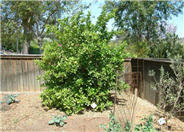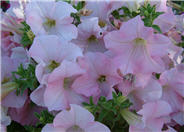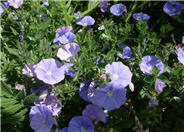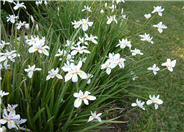
Common name:Improved Meyer Lemon
Botanical name:Citrus X 'Improved Meyer'
Improved Meyer Lemon is an evergreen tree that grows 3'-6' tall and 3'-6' wide; it has year around leaves that are glossy green. This tree likes well drained loam soil, with full sun; medium watering is required. It has white flowers and yellow edible fruit.

Common name:White Birch, European White Birch
Botanical name:Betula pendula
This medium-size weeping tree will grow to about 40' tall and has a whitish/brown bark with deciduous green leaves. This is one tree that can be planted in a lawn area but is not recommended for drought tolerant designs.

Common name:Petunia
Botanical name:Petunia X hybrida
This plant will grow 1'-3' tall and has medium-sized green leaves with multi-colored flowers that bloom in spring and summer.

Common name:Dwarf Morning Glory
Botanical name:Convolvulus sabatius
Convolvulus sabaticus is a perennial that grows 1'-2' high, with branches that spread to 3' or more. It produces blue to lavender flowers with blooms of 1"-2" wide. The soft, evergreen leaves are 1/2" to 1.5" long.

Common name:Carmel Creeper
Botanical name:Ceanothus griseus horizontalis
Carmel Creeper is one of the most popular forms of spreading shrubs. Its glossy oval leaves of 2" are bright green. The tiny, light blue flowers are abundant and form 1" clusters. This shrub benefits from pruning. It does best in well-drained soil with little to no summer water.

Common name:Butterfly-Iris, Fortnight Lily
Botanical name:Dietes iridioides
This clumping evergreen Iris bears tall, narrow leaves to 30" tall and white flowers marked purple in the center on stalks up to 3' tall. This variety has stiffer, darker foliage than the bicolor form. It requires sun to part shade with little or no summer watering when established.
| Designer: The Plant Nerd | Looking Back to the Overhang |
Photographer: GardenSoft |
Soils and Compost:
Physical weed control, including mulching, or hand removal protects the watershed from harmful chemicals.
Water Saving Tip:
Mulching around plants helps retain water and improves the soil.
Integrated Pest Management:
Drip and other smart irrigation delivers water directly to roots, allowing no excess water for weeds.
